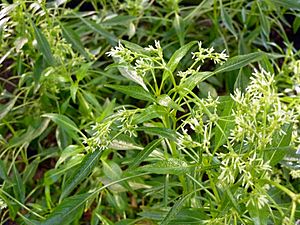Phyllis viscosa facts for kids
Quick facts for kids Phyllis viscosa |
|
|---|---|
 |
|
| Scientific classification |
Phyllis viscosa is a special plant that grows on the island of Tenerife. It is a close relative of Phyllis nobla, but it has its own unique features. This plant is usually smaller than its cousin. Its leaves are narrow and feel a bit sticky to the touch. The flowers grow in short, dense clusters.
Contents
Discovering Phyllis viscosa
What Makes It Special?
Phyllis viscosa is a fascinating plant. Its name, viscosa, actually means "sticky" in Latin. This is because its leaves have a sticky feel. This stickiness might help the plant in different ways. For example, it could protect it from small insects or help it hold onto water in dry places. The plant is also known for its compact size. It does not grow as large as some other plants in its family.
Sticky Leaves and Tiny Flowers
The leaves of Phyllis viscosa are one of its most interesting parts. They are thin and long. When you touch them, you might notice a slight stickiness. This is due to tiny glands on the leaf surface. These glands produce a sticky substance. The flowers of Phyllis viscosa are quite small. They grow together in tight groups. These groups are called inflorescences. They are usually short and dense, making the plant look neat and compact.
Where Does Phyllis viscosa Live?
Its Home in Tenerife
Phyllis viscosa is found only on the island of Tenerife. This island is part of the Canary Islands. These islands are located in the Atlantic Ocean. The plant grows in the western part of Tenerife. You can find it in specific areas like Los Silos and Cuevas Negras. It also thrives in the Montes de Teno region and near Masca.
Growing on Cliffs
This plant loves to grow on cliffs. It prefers the lower parts of these rocky areas. It can be found at elevations up to about 1,000 metres (3,300 ft) (about 3,280 feet). One place where it grows high up is at Cumbre de Masca. Growing on cliffs can be tough for plants. However, Phyllis viscosa is well-adapted to these challenging conditions. It can hold onto the rocks and survive in windy, exposed places.
Life and Survival of Phyllis viscosa
How It Adapts to Its Environment
Living on cliffs in Tenerife means dealing with specific weather. The plant needs to handle strong winds and sometimes dry periods. Its sticky leaves might help it to reduce water loss. They could also trap dust or small particles. This helps the plant get nutrients. Its small size also makes it less exposed to harsh weather.
Reproduction and Life Cycle
Like many plants, Phyllis viscosa reproduces using seeds. Its small flowers likely attract insects. These insects help to pollinate the flowers. After pollination, the plant produces seeds. These seeds then fall to the ground. If conditions are right, they will sprout. This starts a new plant's life cycle. This process helps the plant spread and continue to grow in its special habitat.
Images for kids
See also
 In Spanish: Phyllis viscosa para niños
In Spanish: Phyllis viscosa para niños


